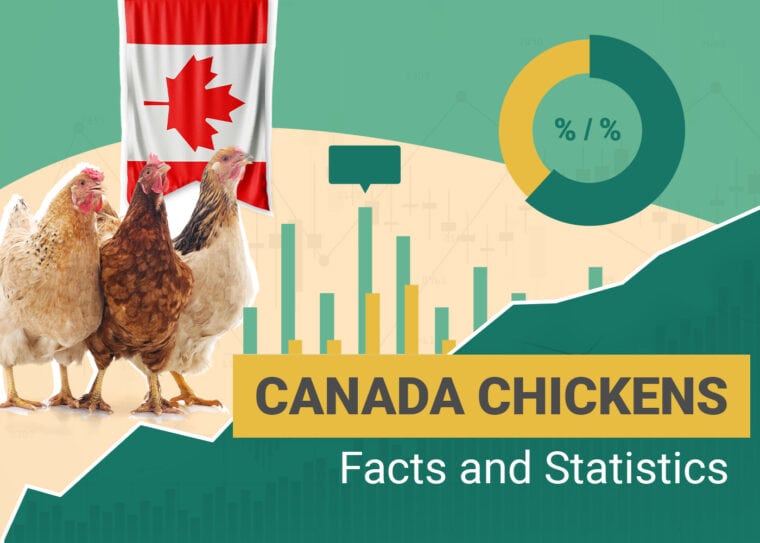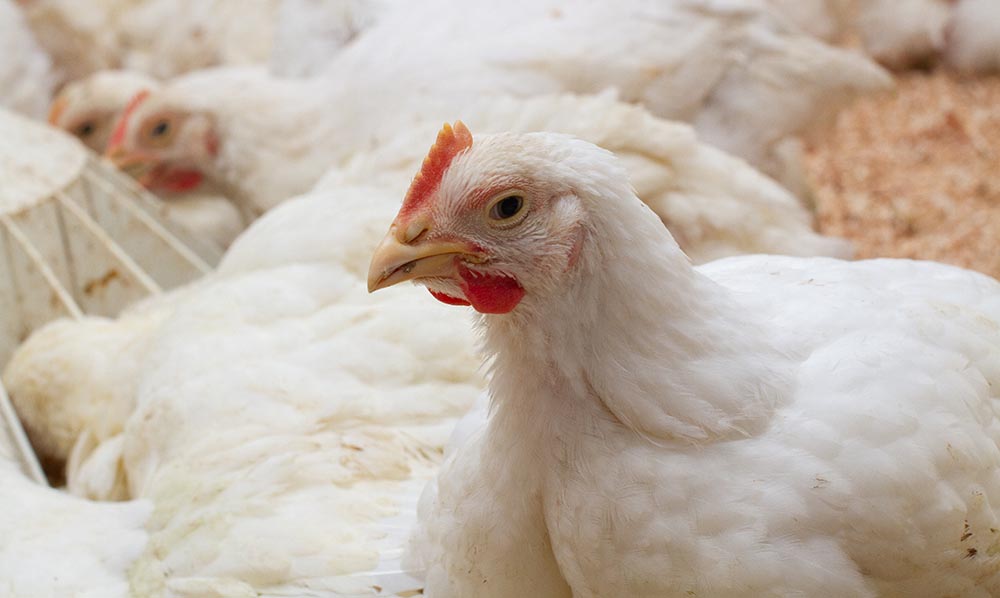
Click to Skip Ahead
Note: This article’s statistics come from third-party sources and do not represent the opinions of this website.
There’s no denying how popular chickens are worldwide for their eggs, meat, and even as backyard pets. There are approximately 25.9 billion chickens around the world,1 with around 150 million chickens living in Canada!
Canada has a robust chicken industry, so let’s take a look at all things chicken as it pertains to this big, beautiful country. We hope that this article will answer just about any question that you might have about these fantastic birds.
Top 16 Canadian Chicken Statistics
- In 2021, there are approximately 152.3 million chickens in Canada.
- In 2021, there were 11.7 million pullets in Canada.
- There were 24.8 million hens in 2021 in Canada.
- There are 107.9 million broilers, roasters, and Cornish hens in Canada.
- There were 7.8 million broiler and layer breeder hens and pullets in 2021.
- There are over 2,000 broiler chicken farms in Canada.
- Ontario has over 630 egg and poultry producers.
- The top three provinces in poultry and egg production are Ontario, Quebec, and B.C.
- Ontario had the highest number of layers at 12.5 million in 2021.
- Canada’s hens produce more than 600 million dozen eggs each year.
- Canadians eat about 19.4 dozen eggs every year.
- The White Leghorn is the most popular chicken for egg production in Canada.
- There are at least 1,200 egg farmers in all of Canada.
- There were 1.3 billion kilograms of chicken produced in 2021.
- In 2021, chicken production in Canada generated $3.3 billion.
- In 2020, each Canadian ate an average of 34.4 kilograms of chicken per person.

Chickens in Canada Statistics
1. In 2021, there were approximately 152.3 million chickens in Canada.
(Statistics Canada)
152 million chickens were reported in 2021 from 23,547 farms. This number reflects farms with broiler chickens, egg-laying hens, and pullets.

2. In 2021, there were 11.7 million pullets in Canada.
(Statistics Canada)
The pullets were under 19 weeks and were intended for laying eggs. These birds were reported by 5,092 farms.
3. There were 24.8 million hens in 2021 in Canada.
(Statistics Canada)
These hens were reported by 18,536 farms. They were all over 19 weeks of age and were used for producing table eggs.
4. There are 107.9 million broilers, roasters, and Cornish hens in Canada.
(Statistics Canada)
These birds were reported by 7,505 farms in 2021.
5. There were 7.8 million broiler and layer breeder hens and pullets in 2021.
(Statistics Canada)
This number makes up the hens and pullets that will be or are used for breeding layers and broilers.
6. There are over 2,000 broiler chicken farms in Canada.
(AgriFarming)
Chickens are Canada’s most popular farmed poultry bird. There are approximately 2,600 chicken farmers and 1,100 egg farmers in Canada.

Chicken and Province Statistics
7. Ontario has over 630 egg and poultry producers.
(Statista)
This makes Ontario the province with the highest number of egg and poultry producers as of 2020.

8. The top three provinces in poultry and egg production are Ontario, Quebec, and B.C.
(Statista)
In 2021, Ontario had 639 poultry-related businesses, Quebec was second highest with 598, followed by B.C. with 338 businesses. The Yukon and Northwest Territories were the lowest, with only 2 businesses each.
9. Ontario had the highest number of layers at 12.5 million in 2021.
(Statista)
Ontario has the highest number of layers, and Quebec has the second highest at about 7.4 million.
Canadians and Eggs Statistics
10. Canada’s hens produce more than 600 million dozen eggs each year.
(AgriFarming)
About 40% of all of Canada’s egg production comes from Ontario.

11. The average Canadian eats about 19.4 dozen eggs every year.
(AgriFarming)
Canadians love their eggs! Those 19.4 dozen eggs work out to about 233 eggs eaten per person every year.
12. The White Leghorn is the most popular chicken for egg production in Canada.
(Agriculture Canada)
Leghorns are independent, confident, and productive egg layers.
13. There are at least 1,200 egg farmers in all of Canada.
(Egg Farmers of Canada)
Most of the eggs that Canadians purchase and enjoy are produced in Canada.

Canadian Chicken Industry Statistics
14. There were 1.3 billion kilograms of chicken produced in 2021.
(Agriculture Canada)
This number is from 2,823 chicken producers in Canada, in which 60% of this amount of chicken came from Ontario and Quebec.
15. In 2021, chicken production in Canada generated $3.3 billion.
(Agriculture Canada)
While this sounds like a large amount, this industry only makes up about 4% of cash receipts for all farming operations.
16. In 2020, each Canadian ate an average of 34.4 kilograms of chicken.
(Agriculture Canada)
This makes chicken the most consumed animal meat protein in Canada, which is actually a slight decrease from the previous year. It’s thought that the COVID-19 pandemic had a negative impact on the chicken industry.

Frequently Asked Questions About Chickens in Canada
What are layers and broilers?
Layers are hens that lay eggs for egg production, which typically provides table eggs. Broilers are chickens that are bred specifically for meat production.
Are there regulations in place to ensure the safety of chickens in Canada?
There are! The Chicken Farmers of Canada follow the Codes of Practice, which started in 1980. The National Farm Animal Care Council helps keep the Code updated. There’s also the Chicken Farmers of Canada’s Raised by a Canadian Farmer Animal Care Program, which allows yearly audits for the humane treatment of the birds.
Animal abuse of any kind is a crime, and any farmer not living up to the Code can be fined and might lose the right to produce any product. (Chicken Farmers of Canada)
How many chickens can I have in my backyard?
This question can only be answered through your municipality’s laws. Bigger cities will have stricter rules. For example, Toronto and Vancouver allow four hens and no roosters, and Halifax allows up to 25 hens depending on the size of the lot. So, you’ll need to check your area’s by-laws before considering backyard chickens.
What are the most popular chicken breeds in Canada?
The White Leghorn was the most popular breed for egg-laying, but the runner-up is the Rhode Island Red. For broilers, the most popular breed is a crossbreed between the Plymouth White Rock and the Cornish White, giving us the Cornish Cross. The Chantecler suits the Canadian climate well. They are hardy and gentle, produce large eggs, and make excellent backyard chickens.

Are Canadian chickens given hormones?
Canada has not used hormones on chickens since 1963. If you encounter a chicken product with “no added hormones” on the label, it’s just marketing, since no chicken available in Canada has added hormones. (Chicken Farmers of Canada)
Conclusion
Chickens give us a few of the most essential products for Canadians. These statistics demonstrate how they keep families fed and are available at affordable prices for anyone on a budget. Also, backyard chickens are growing in popularity!
We hope that these statistics have helped you better understand the poultry industry. If you’re concerned about the humane treatment of chickens, consider only purchasing products with “free run” or “free range” labels, and keep a look out for the “certified humane” label.
- Related Read: How Many Pigs Are There in Canada?
Featured Image Credit: Wild_Strawberries, Shutterstock









